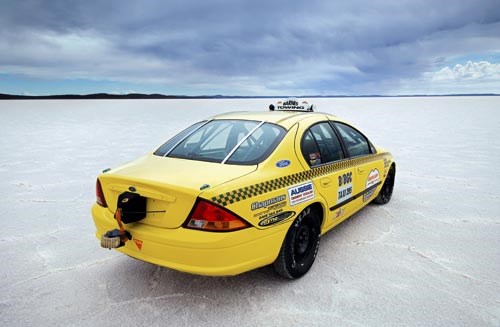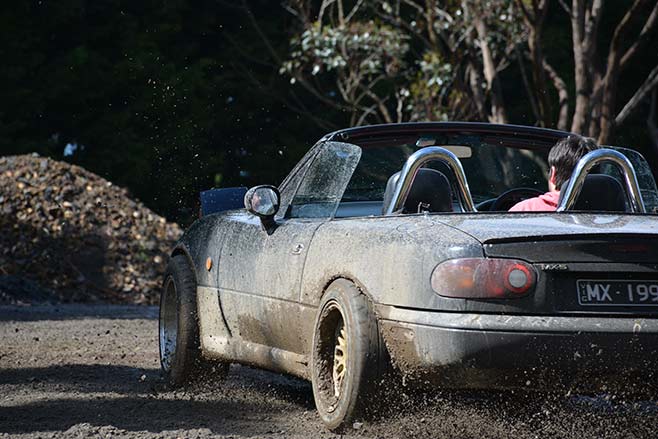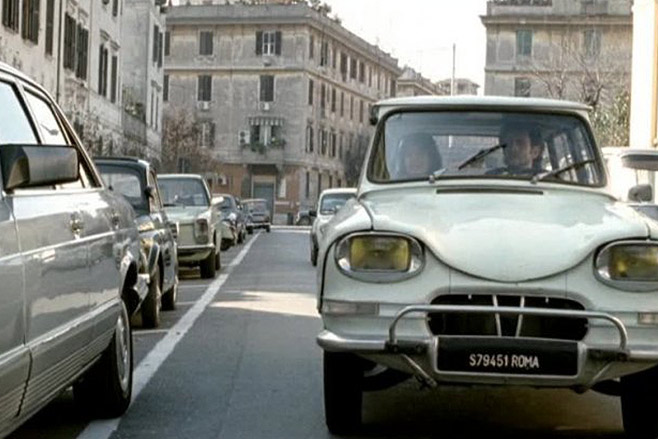Project Car Costs + Bodge Jobs + Centuras - Morley's Workshop 397



|
Our man Morley offers a salutary lesson in keeping tabs on project costs, is alternately appalled and unsurprised by garage bodges, waxes lyrical on the joys of salt flat racing and gets bent out of shape over extreme camber. And Centuras are still not going away
Write to Morley c/o uniquecars@primecreative.com.au
or Unique Cars magazine, 379 Docklands Drive, Docklands, Victoria 3008
MORLEY'S SOAPBOX
I was reminded the other day how some restoration jobs can become monsters. And also that you should always do your sums before committing to a particular plan of attack when it comes to restoring or modifying your car. A good mate of mine has an early, concertina-bumper (G-Series) Porsche 911 in the works. It’s going to be his Sunday car and he’s not too hung-up on originality. He has a point, too, you only need to look at the Porsche 356 Outlaw scene to know that a few tasteful, period-correct mods don’t automatically destroy the value of the car.
One of the things Old Mate wanted to change was the front seats of his 911. I quite like the standard 911 chairs, but he wanted something a bit racier; a bit more Le Mans, if you like. But when he looked at the catalogues of the big suppliers, he was a bit horrified at the cost of buying, importing and adapting a pair of high-end aftermarket pews.
So he got stuck into a few online sites and found a pair of Boxster front seats that had the right basic proportions he was looking for. And, after talking to a motor trimmer who worked locally, he reckoned he could get out of the job for a reasonable wad of folding. But when the job actually got underway, the trimmer discovered that reshaping the Porsche seats wasn’t as easy as they’d both first imagined. Suddenly the hours-quote went through the roof, taking the final price with them.
And, like a lot of seats that are bought off online auction sites, these ones were missing one of the backrest-fold buttons, so that had to be sourced at no small cost, either (given it’s just a little piece of moulded plastic). The seats he wound up with are also electrically operated when my mate would have preferred the lightness and simplicity of manually-adjustable chairs. But you can’t just ignore the electric adjustment (cos there’s no mechanism to adjust them manually) so he’ll have to adapt a wiring harness for the seats (more weight, more complexity). Hopefully all the (untested) electric motors work, too.
All up, the project has cost him a bomb, soured his relationship with a trimmer he was otherwise happy with, and added a bunch of extra weight to a car that’s party trick is being light and pure. And you know what? The seats he really wanted – those high-end, manually-adjustable aftermarket ones – would have worked out cheaper. A whole lot cheaper. Like I said, do your sums first.
HERE'S MY TIP

The big brush-off
Those big, DIY car-wash centres where you put coins in a slot and wash your car at your pace are great. Sort of. But the one piece of equipment you won’t catch me using is the foaming brush. I can’t tell you the number of filthy, muddy four-wheel-drives I’ve seen being cleaned at these car washes, and I can’t believe that at least some of the mud and crap hasn’t been caught in the brush, ready to tear my lovely paint to bits when it’s my turn. I still use these car washes for a quick splash to get the dust off, but that’s about it.

Eeh by gum
I got my first car in 1986, a 1978 Escort with the 1.6 Litre engine. One day I noticed the local garage mechanics had a two-litre donk out of a Cortina sitting out the front. Naturally, a deal was done to do a bit of a re-build and transplant it in the Esky.
With the job done I took it home and noticed that they had somehow put a couple of holes in the radiator during the process and plugged them up with.......chewing gum! I kid you not. The next day I took it back and bluntly pointed this out and asked if they really thought I was stupid enough not to notice that. I still remember ‘the game’s up’ look on their face. The radiator was then sent out to a re-conditioner to be done properly.
As a side note I later owned a white two door RS2000 that was over-bored, had a ported and polished head, cam, extractors and a two inch system. I have never figured it out but it was in no way as quick as that that Escort with the two-litre transplant. One of those little mechanical mysteries.
Craig Polkinghorne,
Yeah, don’t you just love sloppy workshops where close-enough-is-good-enough? Thing is, though – and it’s what grinds my gears the most – is that they really did think you were stupid enough not to notice a lump of Juicy Fruit bunging up the hole in the radiator. Had they not assumed so, they wouldn’t have tried it on.
Mind you, in a certain percentage of cases, they’d have been dead right about the stupid thing. Just not when it comes to you and me, right? And here’s the other sad bit: By no means are the blokes you’re talking about in the minority, attitude-wise. Over the years, I’ve hung around plenty of workshops and panel shops and learned a thing or two about the prevailing attitude towards customer intelligence.
One sparky I dealt (briefly) who used to offer his clientele a `concrete warranty’. Which, of course, meant: `Drive it off that bit of concrete and you’re on your own’. Then there was the panel shop boss I knew who dubbed all his customers lobsters. "Lobsters?" I once asked him. "Yep," he said, "meat in the tail, shit in the head".
All of which makes me wonder how some shops stay in business although, as you’ve pointed out in your case, it was probably because they had the skills to cobble together a bitsa Ford Pinto with enough agates to see off a ported, polished, cammed hot-rod version of the same thing. Then again, I’ve seen this sort of thing heaps of times; an engine made from bits of other engines just seems to work like an absolute beauty. Maybe it’s because every component is worn out to the same extent that it still plays in tune. Examples in my time include an 1100cc Volkswagen engine that would see off 1600cc Beetles and a stock 253 Holden engine that could beat 35 miles to the gallon. Just mechanical freaks, I guess.

The big white dyno
During August last year, I took my family to Speedweek at Bonneville salt flats in Utah. During day two on the salt, we were fortunate to see and hear Danny Thompson’s car do its return run of 404 mph, giving it a combined speed run of 407 mph . The sound of this racer at full tilt will stay with me for ever. Incredible! The people around it all had huge smiles. I hope one day to go back and see more of this magnificent event.
Greg Henkel
I know exactly what you mean when you call this spectacle incredible, Greg. And you’re right; the spectacle is as much about the sound of a salt lake and the air surrounding it being pounded by several thousand horsepower as it is about the sight of a multi-coloured car going at cartoon speeds with a big rooster-tail of salt-spray streaming for a hundred metres behind it.
I think, also, that you’re a bit lucky to have seen the Bonneville event in full swing, because from what I hear, the salt there is depleted and the event was almost called off. For the same reason, I heard on the grapevine that the American big hitters were looking for alternative events around the world to do their thing.
Which brings me to my next point: Did you know Australia has an equivalent (roughly) to Bonneville Speed Week? ‘Tis true. It’s called – funnily enough – Speed Week and it happens around February each year on a salt lake in South Australia called Lake Gairdner. Run by a bunch of hot-rodders who formed themselves into the Dry Lake Racers Australia (DLRA) the event has grown bigger each year and the entrants now number in the hundreds with both bikes and cars able to enter. Actually, that’s selling it short; you’ll find everything from modified sedans to full streamliners and belly-tankers to VW Kombis all aiming for a personal best speed. And on two wheels, I’ve seen everything from sidecars to turbocharged Hayabusas to a postie bike on nitrous. Yep, Lake Gairdner’s got it all.
The catch is that it’s not so easy to get there. In fact, It’s probably a lot easier to fly to Utah and drive to Bonneville. That’s because Lake Gairdner is about 200km north of Iron Knob on a gravel track that can vary from half-decent to bloody awful depending on how long it’s been since the locals put a blade over it. There’s some catering, but it’s strictly camping and BYO everything else. Oh, and as you can imagine, it gets a bit toasty in the South Australian outback in February. But give it some thought, it’s a real hoot and I recommend you attend if you haven’t already been. And don’t take my word for it; ask fellow UC contributor Glenn Torrens who has been racing his little yellow Beetle at Lake Gairdner for the past few years. Our high point was 124 mph and our low point was probably doing an engine change in 47-degrees ambient. Burnt my hand on the spanners I did.

Back in my day…
By design or default UC magazine coverage transcends the odd decade or two. Back in the day, one had `arrived’ if one’s EH, HD or HR sported cut front coils, rear lowering blocks and plenty of side-pipe noise. Mandatory was the inclusion of ‘backyard manufactured’ cut and widened steel wheels upon which narrow radial Pirelli ‘Cinturatos’ or Michelin ‘X’ tyres had been stretched to fit; (the tyre bead barely contacting the rim). All of this aftermarket work was undertaken to meet the highest of engineering standards you understand.
Fast forward to the recent Time Attack day at Eastern Creek (aka SMP) and on display was the latest fashion statement along similar engineering lines. But in this case Toyota-86s and the like were lowered to within about 50mm of the ground, necessitating extremes of negative camber in the region of 35 degrees, for the widened wheels/tyres to clear the wheel arches. Although these machines were seen to be driven in behind the pits they were a no-show on track. Reality dictates that unless equipped like a present day version of a 1960s LA Oldsmobile on hydraulic steroids, then they would have to be a neutered device. A bridge too far maybe!
Eric Waples,
Albion Park, NSW

I guess Eric, it’s a case of the more things change, the more they stay the same. Or something like that. I know the current trend you’re referring to: Crazy negative caster angles and skinny tyres somehow made to hold air after being fitted to too-wide rims.
Let me enlighten you on the whole thing, Eric. There are three words you need to learn: Tuck, poke and stretch. Tuck is keeping the outer edge of the tyre within the wheel arch even on a lowered vehicle. Poke is having the tyres sticking out past the wheel arch on a wide rim. And stretch is what you do to the tyre (by putting a skinny hoop on a wide rim) to prevent poke.
As for the enormous negative camber angles you see on some JDM-style cars… I’m afraid I can’t help you with that one; it remains a mystery to me. Actually, that’s not quite the whole truth because my years dabbling with old VW Beetles taught me that once you lower them, the swing-axle rear suspension automatically adds some negative camber to the equation. The lower you go on swing-axles, the more negative camber you wind up with. I seem to recall elderly BMW 3-Series cars also gained a bit of negative camber when they were lowered because they used a relatively simple independent rear suspension set-up.
None of which explains why kids these days (and those a bit older who should know better) insist on going to the trouble of cutting and welding their hubs to allow for these insane camber angles. If I didn’t know better, I’d be tempted to suggest the trend was invented by somebody retailing tyres, because the wear rate must be astronomical. That’s assuming, of course, that these contraptions are ever driven on the street (and they’re probably not).
But it remains a motoring trend and we should all school ourselves on it lest we look like dumkopfs at the next club meeting. So here’s the skinny: The trend of extreme camber started in Japan in line with the Bosozoku movement. If you’re seen videos of those incredible Japanese cars with absurd added-on body-kits and towering, multiple exhaust pipes, then you know what Bosozoku looks like. If not, Google it. The extreme camber thing morphed out of that movement and is known as oni camber (devil’s camber, I’m told). Those crazy Japanese, eh? So now you know. Now go forth and amuse and amaze your friends with your global knowledge of car modifying.

Centura on the rack
Hey, I just had a chuckle at the Centura Whisky Tango Foxtrot email from Matt Hayward regarding the shaking Centura. Had the same problem with mine and it turned out putting a heavy six in place of a four-cylinder put a lot of burden on the rack-and-pinion steering (non-power steering) and the four bolts holding the rack on used to work loose. I had a monthly maintenance job tightening them and trying Loctite etc but ended up drilling them out and putting bigger bolts in. End of problem.
Years later I found a later model Centura for a run-around and, when I checked, I found Chrysler had also worked out the problem and put larger bolts on the rack. That particular Centura was a bit of a missile `cos I came across a E38 triple Weber 265 Charger motor and put it in the Centura with a four-barrel carb and manifold with extractors and a two-and-a-half inch system. Best sleeper I ever owned and nothing much kept up with it. Apparently the guy I sold it to did pretty good on the drift circuit.
Phil Walter,
I’m loving these highlights-of-a-dangerous-life Centura style. Let me tell you, Phil, you’re not the only bloke with fond if somewhat frightening memories of Centuras and how damn fast they could be made to go.
Maybe what’s surprising me most is that the Centura was a bit of an obscure car back in the day, some kind of a loser-mobile as it aged and, finally, all but forgotten in 2017. Yet here we are, swapping stories about the thing. Brilliant. I should also point out that not one person has contacted this column with a boring story about Centuras.
And you know something else, Phil? I’ll bet London to a brick that somebody out there reads this and a little light-bulb will go off above their head because you’ve just provided them with the fix for the wonky handling they’ve been experiencing in their Centura since 1987.
As for the bloke who bought your car to go competitive drifting: What size straitjacket did he take?
Two stroke confusion
I love two-stroke engines but I think Morley has made a mistake.
The two-stroke diesels he is talking about (GM, Detroit) do not pressurize the crankcase. They look like it with all the oil they leak but they have passages around the cylinder liner which has inlet ports around the circumference. The supercharger or turbo pressurises the passages and the air is forced into the cylinder when the ports open as the piston moves down the bore. Petrol two-strokes compress the air-fuel mix in the crankcase.
Neil Englund,
You are dead right, Neil, I did make a blue there. I was so keen to share my revelation over two-stroke diesels that I didn’t look at the diagram closely enough (I’m no diesel mechanic – or any other sort – that’s for sure). Yep, the pressurised air from the supercharger is pumped into the ports that are exposed when the piston moves far enough down the bore. And, yes again, it passes through a chamber that is sealed off from the crankcase. Mea culpa. However, just like any politician, not knowing how stuff works doesn’t prevent me from wanting to have a fiddle with it. Thanks to all the other readers who pointed out my blunder, too. I’d like to say it won’t happen again, but we all know the reality of that…

Beaut bodges
In Issue 395 you asked about bodgie fixes we’d seen. In the 1960s I was working for a used-car yard in Queanbeyan. Those were the days when you re-lined brakes by riveting new linings on to the shoes; they weren’t all bonded together. Also in those days, school exercise books had cardboard covers with tables on the back, like multiplication, weights and measures.
We got a car in from an auction house in Sydney, an Austin Freeway. The rear brake linings were worn out, they were barely thicker than the heads of the rivets. So they’d been un-riveted, packed out with cut-up pieces of cardboard exercise-book cover, and riveted back on. We were amazed that they hadn’t burned, perhaps being jammed between the linings and shoes stopped that. Bizarre, but it gave the pedal a good feel, and the handbrake worked.
And I don’t know if you heard this 1980s rumour: In Canberra everyone knew about Holden worrying that there was a Falcon V8 expected in 1965. The story was that Holden thought that to compete with that they might fit a V8 into then planned HD, so they fitted some V8s into EH models as test beds. Because of the V8s, they added disc brakes and power steering. Some guys in the 1980s thought that they should be able to automatically register a V8 HD or HR because they claimed that they were designed to take a V8, or an EH if you had disc front brakes and power steering because the factory had done it before. But would you believe, the people at the Motor Registry didn’t agree?
Keep the plugs sparking.
Richard Fisher,
No sense of humour those pen-pushers at the motor registry, eh? I hadn’t actually heard that story, but you can bet your backside I’ll be sharing at the next great pub debate (probably this Friday arvo). And as I always say with regards to these stories of one-off, orphan and experimental cars coming out of head office: Never say never. It kind of stands to reason, too: Holden would surely have had a few spies keeping an eye on what Ford was up to. And a project as big as the first Aussie V8 Falcon would have been pretty difficult to keep a complete lid on. And it’s interesting to think that maybe the whole reason disc brakes and power-steering were made optional on those early Holdens was as a test-bed for the same hardware when the V8 did finally arrive.
I also clapped eyes on a pretty special Falcon XR GT the other day, too. Now, conventional wisdom is that these were all fitted with the 289 cubic-inch V8. Seems not. The one I saw was one of the last two or three dozen made and it was factory-fitted with a 302 cube engine. Ford had always planned to fit the next model, the XT GT, with the 302 but when it ran out of 289s with 30 or 40 XR GT shells still to build, it simply threw the new motor into the XR.
As for your discovery of chunks of cardboard backing up brake linings, I’m kind of horrified but keep them coming folks; if you know of a bodged-up repair that makes you laugh/cry/run and hide, let us know. Laughing at other people’s stupidity mightn’t be very charitable, but it’s a load of fun.
TRIVIAL PURSUIT

When in Rome
So, I’m sitting up late the other night but instead of the usual SBS tits-and-bums fest, a programme called Romanzo Criminale popped up. Anything with Criminale in the title is going to get my attention and the show turned out to be a kind of spaghetti Lock Stock and Two Smoking Barrels deal, but without the gags. It was sub-titled, too, so I nearly turned it off. But here’s the thing, it’s dead-set car-porn. In the episode I saw, cars featured included a 911 Targa, Lancia Fulvia HP, Flavia and Alfas 105 GTV through Giulietta. Hell, even a Citroen Ami 6 gets a starring role! The writers are clearly tappet-heads. And cars like these will always compensate for putting up with sub-titles.

'Stika shock
Heard the one about early Volkswagen Beetle hub-caps? The ones with the big, stamped VW logo on them? The rumour way, way back in the day was that, at a particular speed, the blurring logos on the hub-caps formed swastikas. Fear not, it’s a furphy.
Unique Cars magazine Value Guides
Sell your car for free right here
Get your monthly fix of news, reviews and stories on the greatest cars and minds in the automotive world.
Subscribe

.jpg)








.jpg)






